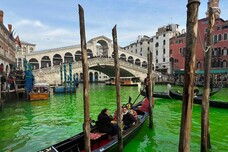(ANSAmed) - NAPLES, 30 GIU - A new underwater route opened on Wednesday for divers, snorkelers and canoeists in the ancient Portus Julius in the underwater archaeological park in Baiae, in the province of Naples.
The underwater structures are submerged between two to five metres deep, due to the bradyseism typical of the Phlegraean Fields.
In ancient times, the structures made up the large industrial and commercial district of Pozzuoli.
This is the section closest to the connection created between the sea and Lake Lucrino where boats coming mainly from Egypt and the East could unload their goods for the Rome market.
In ancient times there were dozens of warehouses at the port, which will now be visible through the new underwater route.
The route, called the "Path of the Columns", contains numerous remains of columns, both in marble and stucco.
The path begins with a forest of walls in which it is easy to get lost, given that what is currently visible is the accumulation of at least 400 years of structures that were built on top of each other through history, which completely changed the orientation or function of the buildings.
It is also likely that this overlap is due to the bradyseism of Baiae, which was present then as it is today.
The lowering of the dry surface must have forced builders to raise the ground level in order to block the water from entering, in particular in these stretches that were at the time closed in between the sea and the lake.
One stretch of the new path includes a sequence of large fallen columns in coloured marble, which probably made up part of the decoration of the last construction that was built here: a large semi-circular space facing the canal, whose function is unknown but which is clearly imposing and would have been seen by ships entering the canal.
The entire route, which runs for about 50 minutes, is suitable for the most expert scuba divers as well as very young snorkelers.
"After months of research, study and technical preparation, we are now able to offer a new visitor experience in the most typical dimension of Phlegraean archaeology, the underwater one," said Fabio Pagano, director of the Phlegraean Fields Archaeological Park.
"The new visitor route dedicated to Portus Iulius allows a dive in space and time through the places where the economic, social and human vitality that made Pozzuoli the great port of Rome and its door wide open to the world came alive," he said. (ANSAmed).
ALL RIGHTS RESERVED © Copyright ANSA











